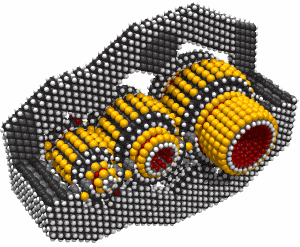While we could assume a separate binding site for each of the low volume catalytic "vitamins" (e.g., Si, Sn, and the transition metal(s)), it would be easier to consolidate them into a single molecule which consisted of two regions: (1) a heterogenous region which included all required elements: Si, Sn, and the transition metal(s); and (2) a region which could be easily bound by a simple binding site. The latter region might be a simple rectangular planar molecule (as discussing in (Merkle, 1997a)). This single molecule would then be dissected by the molecular tools and converted into the needed positionally controlled catalytic agents. This approach reduces the number of binding sites required, and reduces the problem of designing many binding sites which bind uniquely to their own substrate and do not cross-bind to other substrates. On the other hand, it requires additional steps to convert the "vitamin" into useful structures. As the "vitamin" molecule can presumably be designed to simplify this process, and as it would be necessary to convert precursors into their active form in any event, this approach seems more attractive than the alternative of using a multitude of binding sites each tuned to a specific feedstock molecule.
This leaves us with a feedstock that consists of four main components:
- Acetone (the solvent)
- Butadiyne
- The "vitamin" molecule
- Neon
The vitamin need be present only in low concentration, which eases concerns about its solubility. Neon is small enough that solubility is not a significant issue. Butadiyne (like acetylene) is soluble in acetone.
We can view these four molecules as zero dimensional (neon), one dimensional (butadiyne), two dimensional (the 2-d tab on the vitamin), and three dimensional (acetone). This simplifies the interactions between the binding sites. Molecules of higher dimensionality cannot fit into binding sites of lower dimensionality, while molecules of lower dimensionality will have much lower affinity for binding sites of higher dimensionality. For example, almost nothing will fit into a snug binding site designed for neon. Impurities that can reasonably be expected to enter through a neon binding site are helium and H2. The former is harmless in small amounts, while the latter can be gettered from the external feedstock solution, thus insuring that the concentration of H2 in the feedstock solution is so small that it can be neglected.
In cases where a contaminant of lower dimension has a sufficient affinity for a binding site of higher dimension that it might be a problem, a specific method of eliminating the contaminant will be required. Most generally, the multi-staged cascade approach (Drexler, 1992) could be used. It is reasonable to expect that more special-purpose (and simpler) approaches will be sufficient for the present proposal (e.g., gettering of hydrogen).

No comments:
Post a Comment